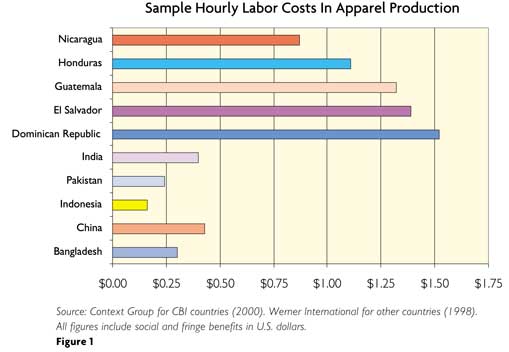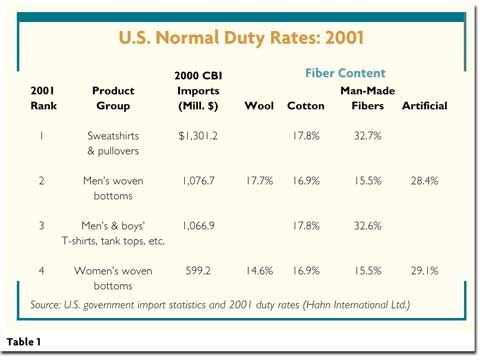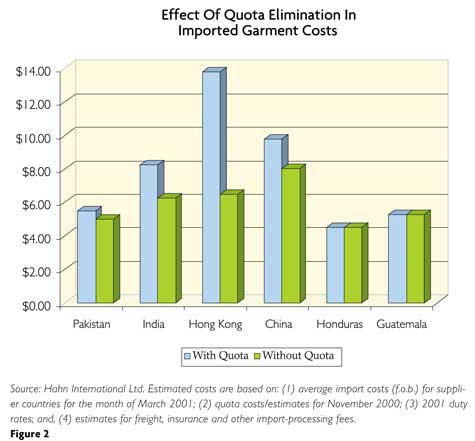Add Value Or Else
A Caribbean Basin Initiative strategy for U.S. mills Despite all the high hopes and
hoopla surrounding the passage last year of the Caribbean Basin trade legislation, the results,
thus far, have been disappointing for most U.S. mills producing apparel fabrics or yarns. There is
little doubt that imports of apparel products from the region will grow over the next few years.
The real question is whether the Caribbean Basin Initiative (CBI) region can compete in the long
term with other apparel-producing regions especially after the quotas are removed on apparel
imports from other countries in 2005.For producers of apparel fabrics and yarns, this situation is
particularly critical. Like it or not, U.S. apparel production will continue to decline, and
imports of finished garments will continue to increase. Even the most competitive U.S. producer of
apparel fabrics or yarns will find it hard, if not impossible, to prosper without a competitive
downstream customer.The other cold reality is that retailers and wholesalers of apparel products
will always be forced to chase the cheap needle. And even though labor costs today are considerably
lower in the CBI region than in the United States they are still considerably higher than in other
less-developed countries in Southeast Asia, the Indian Subcontinent and Africa.

Elimination Of Quotas Will Reduce CBI AdvantageBy far, the biggest and most important
advantage for the CBI region is in the zero-duty rate on qualifying garments, i.e. those made from
U.S. fabrics and yarns. Currently, that advantage is significant in many key product
classifications when compared to the duty rates on imports from Asia and other regions.Figure 1
shows the top imports from the CBI region in 2000 and the duty rates that would apply to the same
garments imported from China, India or most other countries.Unfortunately for the CBI region (and
Mexico), the elimination of import quotas (not duties) on other countries in 2005 will cut deeply
into that competitive advantage.For most imports still covered by U.S. quota restrictions and that
includes most apparel products there is frequently a cost associated with acquiring the export visa
in the supplier country. The quota cost if there is one is usually reflected in the f.o.b. cost of
the garment from the foreign manufacturer. The cost of quota can vary significantly from country to
country, depending on U.S. market demand for the product, the capabilities of manufacturers in a
particular country, and the quantity of quota available in that country for that quota year. Quota
costs also rise and fall during the quota year.In some countries such as Hong Kong and China the
quota charge can be significant.Figure 2 illustrates the before and after impact of the elimination
of import quotas on one important product classification mens cotton polo shirts.Its clear from
this example that factories producing polo-style shirts in the CBI region could easily find
themselves after 2005 at a competitive disadvantage with producers in lower-cost countries such as
Pakistan and for moderate- to better-quality polo shirts from countries such as Hong Kong, China
and India. The same, of course, applies to other products as well.

CBI Region Lacks Packaging Infrastructure Or FacilitatorsAnother challenge facing the CBI
region is the growing demand for full-package garment production from U.S. wholesalers and
retailers. Unfortunately, few independent garment factories in the region have the capability to
offer full-package services due to financing limitations, lack of knowledge about U.S. fabric and
trim sources, inadequate pattern-making or fabric-cutting capabilities, and other critical elements
of full-package production. Likewise, few independent factories in the region can offer the type of
product development support or quick turnarounds on samples or pricing as can their Asian
competitors.While there are some U.S. companies such as Perry Ellis International, VF Corp.,
Kellwood, Tropical Sportswear and others that can effectively facilitate or manage full-package
production in the region, theres room for more. Although the Asians are well-represented with
factories in the region, most of the fabric and trim purchasing and other coordination/facilitation
is done through their Asian offices which puts U.S. mills at a disadvantage.The situation begs for
more facilitators or aggregators to step in and fill this role. The recent formation of the
Amerisource Group is a step in the right direction. Hopefully, for U.S. mills, others will
follow.

Long-Term Strategy: Add ValueFor the short term, U.S. producers of apparel fabrics and yarns
have little choice but to focus on those product groups in which North American producers are
currently the most competitive bottom-weight cotton fabrics and basic cotton knits for T-shirts,
sweatshirts and underwear. However, for the longer term, U.S. mills are going to need a different
approach in order to prosper.1.Focus on higher-value fabrics.With CBI labor costs already high in
relation to other lower-cost countries such as Pakistan, India and Bangladesh, its critically
important for the long term to reduce the labor-cost component in garments produced in the region
without lowering the value of the product. The best way to do that is to increase the value of the
fabric in the garment.Finding ways to increase the use of better-quality wool and synthetic fabrics
in mens and womens dress slacks would be one example of a strategy that could work for the
region.2.Forge alliances with best-of-class knitters and finishers.The lack of knitting capacity in
the CBI region is proving to be a real obstacle for U.S. yarn spinners. Yarn spinners should be
forging alliances with top-quality U.S. knitters to do full-package production of better-quality
knit garments in the CBI region, or else looking for an Asian partner that is willing to build a
knitting plant in the region. Likewise, U.S. greige weavers need to partner with best-of-class U.S.
finishers to produce better-quality bottom-weight or shirting fabrics.3.Upgrade the capabilities of
CBI factories.Using the best fabrics alone will not be enough if the CBI region cannot meet the
quality standards or price points of U.S. retailers and wholesalers. Just looking at the list of
top imports from the region, one sees the current focus on basic, relatively low-labor-content
products like T-shirts, jeans and underwear. Unless factories can upgrade their sewing skills and
productivity over time, they will be displaced by new low-cost suppliers in other regions.U.S.
mills need to be identifying and partnering with factories in the region that have the will and the
resources to upgrade their capabilities. In many cases, these will be Asian-owned plants with
headquarters in Asia. Calling on those factory owners should be a top priority. Making the economic
case for the use of U.S. fabrics in CBI production will also be required.4.Find the
aggregators.Likewise, U.S. mills need to be forging alliances with U.S. and Asian aggregators doing
production in the CBI region. These companies can bring the essential sourcing network, logistical
and financing capabilities, product development support, and most importantly the customers to the
table.5. Develop product sourcing infrastructure and outsourcing capability.Last but not least,
U.S. yarn spinners, knitters and weavers should not put all of their eggs in the CBI basket. While
the CBI region and Mexico can provide economical alternatives to U.S. apparel production, the
strict rules of origin requiring the use of U.S. fabrics and yarns can be both a blessing and a
curse. In order to reduce costs, move up the value chain and meet the future needs of U.S.
retailers and wholesalers, U.S. mills are, in some cases, going to have to supplement their use of
local yarns and fabrics with imported products.Using imported yarns, however, does not necessarily
rule out the possibility of lower-cost apparel production in North America. Under NAFTA rules, sewn
product assembled in Mexico can still qualify for full NAFTA benefits zero duties and no quotas as
long as the fabric is formed and cut in the U.S. This rule creates opportunities to use imported
yarns to upgrade a knit or woven fabric and still meet the pricing requirements of a U.S.
wholesaler or retailer.
Editors Note: Jim Langlois is executive director of Hahn International Ltd., Stamford, Conn, a
company that helps its industry clients develop and execute strategies to stimulate growth and
profitability in the North American market.Hahns team of senior professionals and strategic
alliances with other industry specialists bring strategic planning, market research methodologies
and access to top executives throughout the fiber, textile, apparel and retail supply chains. The
company has extensive hands-on experience in production, marketing, importing and exporting of
textile-related products. For more information visitwww.hahninternational.com.
October 2001




